|
|
General: LAST SUPPER=TRUE VALUE PI=PHI=TABERNACLE=SALM 119 (911)=TRAVEL THROUGH TIME
Triar un altre plafó de missatges |
|
|
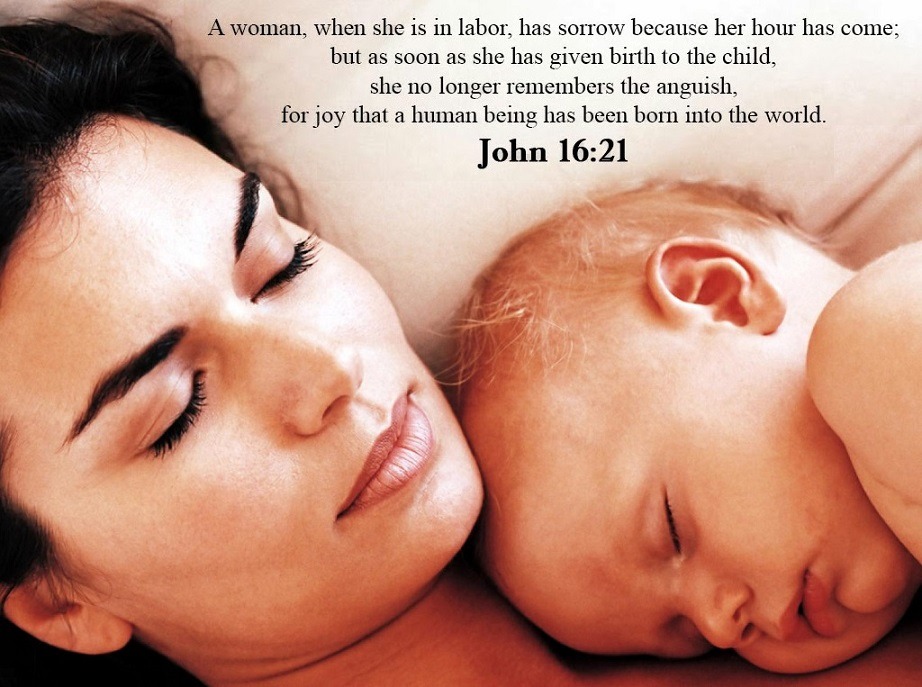
25 DE ABRIL=DIA DE SAN MARCOS
22 DE JULIO=DIA DE MARIA LA MAGDALENA
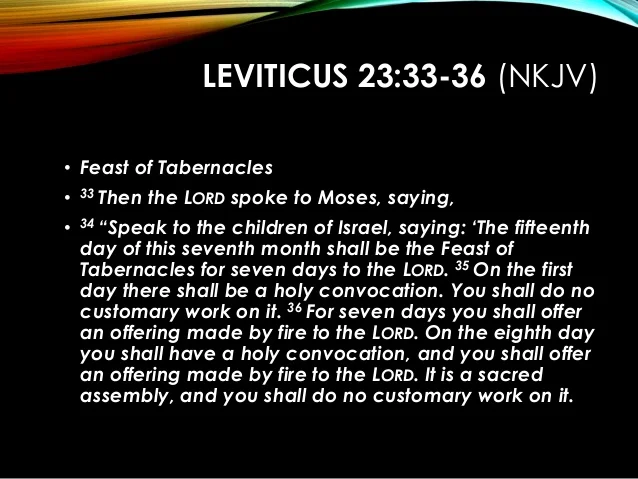
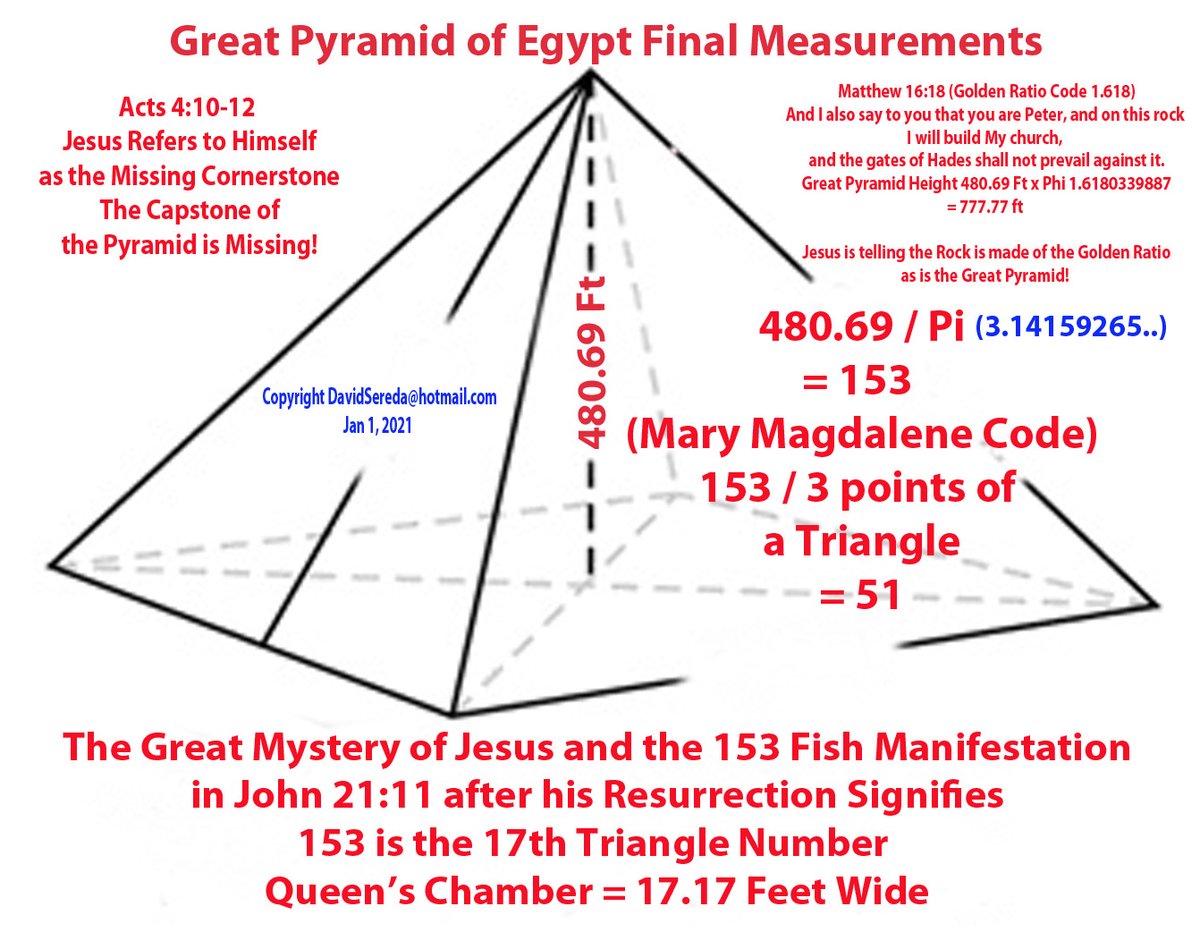
S. JUAN 7
Incredulidad de los hermanos de Jesús
1Después de estas cosas, andaba Jesús en Galilea; pues no quería andar en Judea, porque los judíos procuraban matarle. 2Estaba cerca la fiesta de los judíos, la de los tabernáculos; (LEVITICO 23:33,44)
3y le dijeron sus hermanos: Sal de aquí, y vete a Judea, para que también tus discípulos vean las obras que haces. 4Porque ninguno que procura darse a conocer hace algo en secreto. Si estas cosas haces, manifiéstate al mundo. 5Porque ni aun sus hermanos creían en él. 6Entonces Jesús les dijo: Mi tiempo aún no ha llegado, mas vuestro tiempo siempre está presto. 7No puede el mundo aborreceros a vosotros; mas a mí me aborrece, porque yo testifico de él, que sus obras son malas. 8Subid vosotros a la fiesta; yo no subo todavía a esa fiesta, porque mi tiempo aún no se ha cumplido. 9Y habiéndoles dicho esto, se quedó en Galilea.
Jesús en la fiesta de los tabernáculos
10Pero después que sus hermanos habían subido, entonces él también subió a la fiesta, no abiertamente, sino como en secreto. 11Y le buscaban los judíos en la fiesta, y decían: ¿Dónde está aquel? 12Y había gran murmullo acerca de él entre la multitud, pues unos decían: Es bueno; pero otros decían: No, sino que engaña al pueblo. 13Pero ninguno hablaba abiertamente de él, por miedo a los judíos.
14Mas a la mitad de la fiesta subió Jesús al templo, y enseñaba. 15Y se maravillaban los judíos, diciendo: ¿Cómo sabe este letras, sin haber estudiado? 16Jesús les respondió y dijo: Mi doctrina no es mía, sino de aquel que me envió. 17El que quiera hacer la voluntad de Dios, conocerá si la doctrina es de Dios, o si yo hablo por mi propia cuenta. 18El que habla por su propia cuenta, su propia gloria busca; pero el que busca la gloria del que le envió, este es verdadero, y no hay en él injusticia. 19¿No os dio Moisés la ley, y ninguno de vosotros cumple la ley? ¿Por qué procuráis matarme? 20Respondió la multitud y dijo: Demonio tienes; ¿quién procura matarte? 21Jesús respondió y les dijo: Una obra hice, y todos os maravilláis. 22Por cierto, Moisés os dio la circuncisión (no porque sea de Moisés, sino de los padres); y en el día de reposo circuncidáis al hombre. 23Si recibe el hombre la circuncisión en el día de reposo, para que la ley de Moisés no sea quebrantada, ¿os enojáis conmigo porque en el día de reposo sané completamente a un hombre? 24No juzguéis según las apariencias, sino juzgad con justo juicio.
¿Es este el Cristo?
25Decían entonces unos de Jerusalén: ¿No es este a quien buscan para matarle? 26Pues mirad, habla públicamente, y no le dicen nada. ¿Habrán reconocido en verdad los gobernantes que este es el Cristo? 27Pero este, sabemos de dónde es; mas cuando venga el Cristo, nadie sabrá de dónde sea. 28Jesús entonces, enseñando en el templo, alzó la voz y dijo: A mí me conocéis, y sabéis de dónde soy; y no he venido de mí mismo, pero el que me envió es verdadero, a quien vosotros no conocéis. 29Pero yo le conozco, porque de él procedo, y él me envió. 30Entonces procuraban prenderle; pero ninguno le echó mano, porque aún no había llegado su hora. 31Y muchos de la multitud creyeron en él, y decían: El Cristo, cuando venga, ¿hará más señales que las que este hace?
Los fariseos envían alguaciles para prender a Jesús
32Los fariseos oyeron a la gente que murmuraba de él estas cosas; y los principales sacerdotes y los fariseos enviaron alguaciles para que le prendiesen. 33Entonces Jesús dijo: Todavía un poco de tiempo estaré con vosotros, e iré al que me envió. 34Me buscaréis, y no me hallaréis; y a donde yo estaré, vosotros no podréis venir. 35Entonces los judíos dijeron entre sí: ¿Adónde se irá este, que no le hallemos? ¿Se irá a los dispersos entre los griegos, y enseñará a los griegos? 36¿Qué significa esto que dijo: Me buscaréis, y no me hallaréis; y a donde yo estaré, vosotros no podréis venir?
Ríos de agua viva
37En el último y gran día de la fiesta, Jesús se puso en pie y alzó la voz, diciendo: Si alguno tiene sed, venga a mí y beba. (SEPTIMO DIA DE LA FIESTA DE LOS TABERNACULOS O OSHANAH RABBAH=21 DE TISHRI O SEPTIMO MES HEBREO) 38El que cree en mí, como dice la Escritura, de su interior correrán ríos de agua viva. 39Esto dijo del Espíritu que habían de recibir los que creyesen en él; pues aún no había venido el Espíritu Santo, porque Jesús no había sido aún glorificado.
S. JUAN 8

1y Jesús se fue al monte de los Olivos. 2Y por la mañana volvió al templo, y todo el pueblo vino a él; y sentado él, les enseñaba. (Octavo dia de la FIESTA DE LOS TABERNACULOS O 22 DE TISHRI O 22 DEL SEPTIMO MES HEBREO. 22/7) 3Entonces los escribas y los fariseos le trajeron una mujer sorprendida en adulterio; y poniéndola en medio, 4le dijeron: Maestro, esta mujer ha sido sorprendida en el acto mismo de adulterio. 5Y en la ley nos mandó Moisés apedrear a tales mujeres. Tú, pues, ¿qué dices? 6Mas esto decían tentándole, para poder acusarle. Pero Jesús, inclinado hacia el suelo, escribía en tierra con el dedo. 7Y como insistieran en preguntarle, se enderezó y les dijo: El que de vosotros esté sin pecado sea el primero en arrojar la piedra contra ella. 8E inclinándose de nuevo hacia el suelo, siguió escribiendo en tierra. 9Pero ellos, al oír esto, acusados por su conciencia, salían uno a uno, comenzando desde los más viejos hasta los postreros; y quedó solo Jesús, y la mujer que estaba en medio. 10Enderezándose Jesús, y no viendo a nadie sino a la mujer, le dijo: Mujer, ¿dónde están los que te acusaban? ¿Ninguno te condenó? 11Ella dijo: Ninguno, Señor. Entonces Jesús le dijo: Ni yo te condeno; vete, y no peques más.
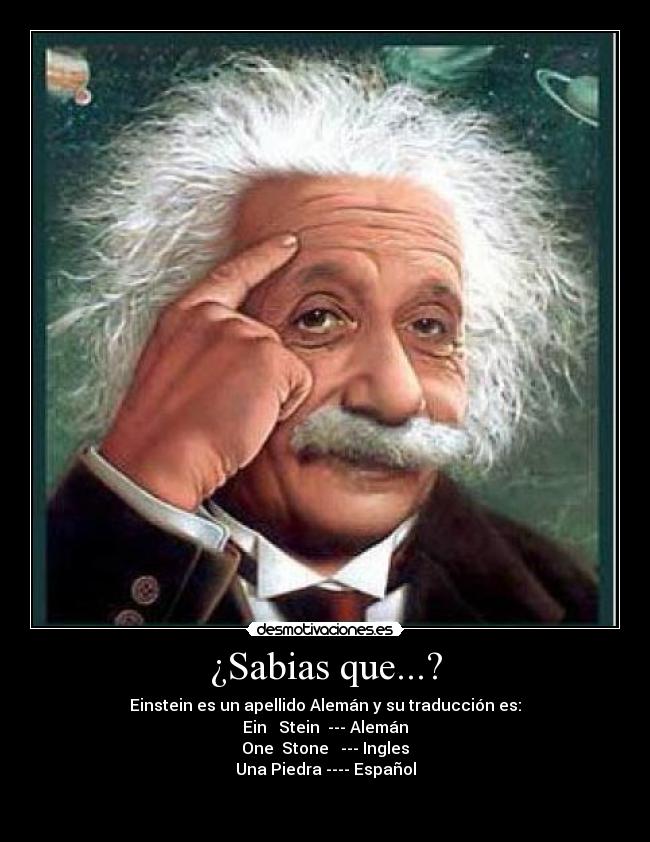
Jesús, la luz del mundo
12Otra vez Jesús les habló, diciendo: Yo soy la luz del mundo; el que me sigue, no andará en tinieblas, sino que tendrá la luz de la vida. (En el octavo dia de la fiesta de los tabernaculos, osea el 22/7=3.14, NUESTRO SEÑOR JESUCRISTO HACE REFERENCIA A QUE EL ES LA LUZ. ¿CONOCIA QUE LA LUZ ES UNA ONDA ELECTROMAGNETICA, OSEA QUE ES UNA ONDA SINUSOIDAL EN FUNCION A LOS GRADOS SEXAGECIMALES? ¿PORQUE JUSTO EN EL DIA DE SIMCHAT TORAH, QUE SE LEE EL SALMO 119 NUESTRO SEÑOR DICE QUE EL ES LA LUZ? ¿CONOCIA LA LEY DE LA RELATIVIDAD DE EINSTEIN? ¿PORQUE EINSTEIN NACIO UN 14 DE MARZO, OSEA UNA REFERENCIA AL 3.14? ¿PORQUE TIENE UN NEXO 911 EN EL MARCO A JUAN 8:32, OSEA UNA REFERENCIA AL SALMO 119 ESPECIFICAMENTE? NO ES CASUALIDAD QUE NUESTRO SEÑOR AFIRMA QUE EL ES LA LUZ, EN EL MARCO AL NUMERO 22/7=3.14, DANDOLE UN NEXO PI-RAMIDAL. ES OBVIO QUE CONOCIA LA LEY DE LA RELATIVIDAD DE EINSTEIN E INCLUSO SABIA QUE LA LUZ ES UN FENOMENO ONDULATORIO COMO LO CONFIRMO MAXWELL EN EL SIGLO XIX).
13Entonces los fariseos le dijeron: Tú das testimonio acerca de ti mismo; tu testimonio no es verdadero. 14Respondió Jesús y les dijo: Aunque yo doy testimonio acerca de mí mismo, mi testimonio es verdadero, porque sé de dónde he venido y a dónde voy; pero vosotros no sabéis de dónde vengo, ni a dónde voy. 15Vosotros juzgáis según la carne; yo no juzgo a nadie. 16Y si yo juzgo, mi juicio es verdadero; porque no soy yo solo, sino yo y el que me envió, el Padre. 17Y en vuestra ley está escrito que el testimonio de dos hombres es verdadero. 18Yo soy el que doy testimonio de mí mismo, y el Padre que me envió da testimonio de mí.
19Ellos le dijeron: ¿Dónde está tu Padre? Respondió Jesús: Ni a mí me conocéis, ni a mi Padre; si a mí me conocieseis, también a mi Padre conoceríais. 20Estas palabras habló Jesús en el lugar de las ofrendas, enseñando en el templo; y nadie le prendió, porque aún no había llegado su hora.
A donde yo voy, vosotros no podéis venir
21Otra vez les dijo Jesús: Yo me voy, y me buscaréis, pero en vuestro pecado moriréis; a donde yo voy, vosotros no podéis venir. 22Decían entonces los judíos: ¿Acaso se matará a sí mismo, que dice: A donde yo voy, vosotros no podéis venir? 23Y les dijo: Vosotros sois de abajo, yo soy de arriba; vosotros sois de este mundo, yo no soy de este mundo. 24Por eso os dije que moriréis en vuestros pecados; porque si no creéis que yo soy, en vuestros pecados moriréis. 25Entonces le dijeron: ¿Tú quién eres? Entonces Jesús les dijo: Lo que desde el principio os he dicho. 26Muchas cosas tengo que decir y juzgar de vosotros; pero el que me envió es verdadero; y yo, lo que he oído de él, esto hablo al mundo. 27Pero no entendieron que les hablaba del Padre. 28Les dijo, pues, Jesús: Cuando hayáis levantado al Hijo del Hombre, entonces conoceréis que yo soy, y que nada hago por mí mismo, sino que según me enseñó el Padre, así hablo. 29Porque el que me envió, conmigo está; no me ha dejado solo el Padre, porque yo hago siempre lo que le agrada. 30Hablando él estas cosas, muchos creyeron en él.
La verdad os hará libres
31Dijo entonces Jesús a los judíos que habían creído en él: Si vosotros permaneciereis en mi palabra, seréis verdaderamente mis discípulos; 32y conoceréis la verdad, y la verdad os hará libres.
33Le respondieron: Linaje de Abraham somos, y jamás hemos sido esclavos de nadie. ¿Cómo dices tú: Seréis libres?
34Jesús les respondió: De cierto, de cierto os digo, que todo aquel que hace pecado, esclavo es del pecado. 35Y el esclavo no queda en la casa para siempre; el hijo sí queda para siempre. 36Así que, si el Hijo os libertare, seréis verdaderamente libres. 37Sé que sois descendientes de Abraham; pero procuráis matarme, porque mi palabra no halla cabida en vosotros. 38Yo hablo lo que he visto cerca del Padre; y vosotros hacéis lo que habéis oído cerca de vuestro padre.
Sois de vuestro padre el diablo
39Respondieron y le dijeron: Nuestro padre es Abraham. Jesús les dijo: Si fueseis hijos de Abraham, las obras de Abraham haríais. 40Pero ahora procuráis matarme a mí, hombre que os he hablado la verdad, la cual he oído de Dios; no hizo esto Abraham. 41Vosotros hacéis las obras de vuestro padre. Entonces le dijeron: Nosotros no somos nacidos de fornicación; un padre tenemos, que es Dios. 42Jesús entonces les dijo: Si vuestro padre fuese Dios, ciertamente me amaríais; porque yo de Dios he salido, y he venido; pues no he venido de mí mismo, sino que él me envió. 43¿Por qué no entendéis mi lenguaje? Porque no podéis escuchar mi palabra. 44Vosotros sois de vuestro padre el diablo, y los deseos de vuestro padre queréis hacer. Él ha sido homicida desde el principio, y no ha permanecido en la verdad, porque no hay verdad en él. Cuando habla mentira, de suyo habla; porque es mentiroso, y padre de mentira. 45Y a mí, porque digo la verdad, no me creéis. 46¿Quién de vosotros me redarguye de pecado? Pues si digo la verdad, ¿por qué vosotros no me creéis? 47El que es de Dios, las palabras de Dios oye; por esto no las oís vosotros, porque no sois de Dios.
La preexistencia de Cristo
48Respondieron entonces los judíos, y le dijeron: ¿No decimos bien nosotros, que tú eres samaritano, y que tienes demonio? 49Respondió Jesús: Yo no tengo demonio, antes honro a mi Padre; y vosotros me deshonráis. 50Pero yo no busco mi gloria; hay quien la busca, y juzga. 51De cierto, de cierto os digo, que el que guarda mi palabra, nunca verá muerte. 52Entonces los judíos le dijeron: Ahora conocemos que tienes demonio. Abraham murió, y los profetas; y tú dices: El que guarda mi palabra, nunca sufrirá muerte. 53¿Eres tú acaso mayor que nuestro padre Abraham, el cual murió? ¡Y los profetas murieron! ¿Quién te haces a ti mismo? 54Respondió Jesús: Si yo me glorifico a mí mismo, mi gloria nada es; mi Padre es el que me glorifica, el que vosotros decís que es vuestro Dios. 55Pero vosotros no le conocéis; mas yo le conozco, y si dijere que no le conozco, sería mentiroso como vosotros; pero le conozco, y guardo su palabra. 56Abraham vuestro padre se gozó de que había de ver mi día; y lo vio, y se gozó. 57Entonces le dijeron los judíos: Aún no tienes cincuenta años, ¿y has visto a Abraham? 58Jesús les dijo: De cierto, de cierto os digo: Antes que Abraham fuese, yo soy. 59Tomaron entonces piedras para arrojárselas; pero Jesús se escondió y salió del templo; y atravesando por en medio de ellos, se fue.

|
|
|
|
|
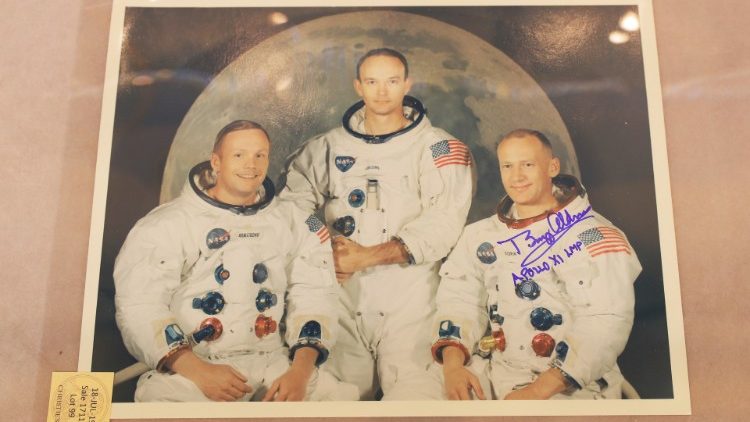 archivo archivo
13 julio 1969: Pablo VI recuerda en ángelus la primera misión del "Apollo 11"
El Osservatore Romano, recuerda esta efemérides, en lo que fue un momento histórico, que marco el mundo. Marcello Filotei recuerda el 20 de julio cuando los astronautas llegaron a la luna
Patricia Ynestroza-Ciudad del Vaticano
“La ciencia ficción se hizo realidad el 20 de julio de 1969, cuando los astronautas estadounidenses Neil Armstrong y Buzz Aldrin pisaron la luna a la que habían llegado después de cuatro días de viaje a bordo del Apollo 11. El tercer miembro de la misión, Michael Collins tuvo mala suerte, a pesar de que él dijo que no”.
Filotei recuerda que Collins era el único que podía pilotar el módulo de mando, y tenía que permanecer en órbita mientras los otros dos saltaban a la superficie lunar mientras el mundo los miraba en mundovisión. Era necesario, sin él, la misión no habría tenido éxito, pero no “debería haber sido fácil mantenerse alejado como Moisés para contemplar la "Luna prometida" sin poder alcanzarla. En cada órbita durante 48 minutos permaneció fuera del contacto por radio con la Tierra, las emociones que sintió, según informó, no eran de miedo ni de soledad, sino de "conciencia, anticipación, satisfacción, confianza, casi exaltación". En cualquier caso, continuó: "es desde los tiempos de Adán que nadie ha conocido semejante soledad humana".”
El momento de bajar a la luna
Los otros dos astronautas, tomaron más tiempo del esperado para salir del transbordador, “porque la mochila que llevaban detrás de ellos para asegurar su supervivencia era demasiado grande para pasar fácilmente por la escotilla”, cuenta Filotei, después de haber recolectado más de veinte kilogramos de piedras y haber plantado la bandera, en realidad solo lograron clavarla algunos centímetros porque el suelo era particularmente duro, regresaron a la nave.
Ante las maravillas de Dios ¿qué es el hombre?
Armstrong y Aldrin antes de regresar a la nave, dejaron en la superficie lunar una placa de oro en la que estaba grabado el Salmo 8: "Cuando veo tus cielos, obra de tus dedos, la luna y las estrellas que tú formaste, Digo: ¿Qué es el hombre, para que tengas de él memoria, y el hijo del hombre, para que lo visites? Le has hecho poco menor que los ángeles, y lo coronaste de gloria y de honra. Le hiciste señorear sobre las obras de tus manos; Todo lo pusiste debajo de sus pies”.
Papa Pablo VI quiso este mensaje en la luna
El mensaje al cosmos le había sido confiado por Pablo VI, quien ya había dirigido su pensamiento a la misión una semana antes. Fue el 13 de julio cuando el Papa Montini enfatizó que el momento iba "más allá de los elementos descriptivos de este hecho único y maravilloso". Se estaba haciendo historia y lo que más sorprendió al Papa fue "ver que no se trata de sueños". "La ciencia ficción se convierte en realidad", dijo, pero no se detuvo allí, sino que captó un aspecto particular de la misión: "Si consideramos la organización de cerebros, actividades, instrumentos, medios económicos, con todos los estudios, experimentos, Los intentos, la hazaña, la admiración se convierte en reflexión y la reflexión se curva sobre el hombre, el mundo, la civilización, de donde brotan novedades de tal sabiduría y de tal poder ".
Una vez más volvieron a surgir las preguntas habituales: "¿Quién es capaz de hacer tanto? tan pequeño, tan frágil, tan similar al animal, que no cambia y no sobrepasa por sí mismo los límites de sus instintos naturales, y tan superior, tan maestro de las cosas, ¿tan victorioso en el tiempo y el espacio? ¿Quiénes somos? Seiscientos millones de personas vieron la luna en vivo. La intuición de Pablo VI llamó la atención sobre la mano del hombre, colocando "esta criatura de Dios, incluso más que la misteriosa Luna, en el centro de este viaje".
https://www.vaticannews.va/es/papa/news/2019-07/efemerides-papa-pablo-vi-llegada-a-la-luna.html |
|
|
|
|
|
|
|
LAST UPDATED: 27 NOVEMBER 2024
You may know Paris for its cathedral Notre-Dame, the Eiffel Tower, its café culture and its amazing museums and art galleries. The French capital is also famous for its fantastic perspective that runs from the Louvre to La Défense. This is the ‘Voie Triomphale’, aka the Historical Axis of Paris.
This line is one of the most prestigious perspectives in the world. In fact, its design has inspired cities such as Buenos Aires, Washington DC, New Delhi and Canberra. In this article, we’ll learn more about the Historical Axis of Paris. We’ll discover the stunning monuments and I reveal to you some stunning facts.
What is the Historical Axis of Paris?
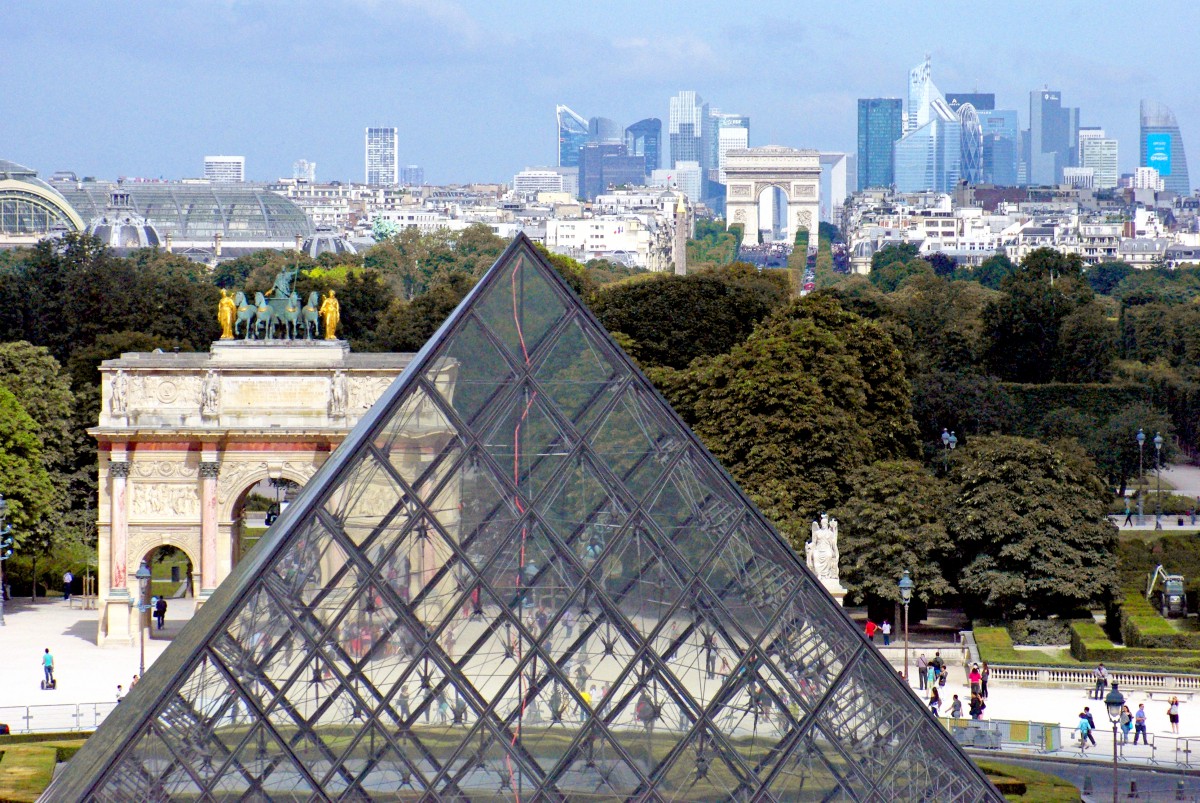 The glass pyramid and the historical axis of Paris © French Moments The glass pyramid and the historical axis of Paris © French Moments
The Historical Axis, also known in French as “Axe Historique”, “Voie Triomphale” or “Voie Royale” is orientated on a 26° angle.
It follows the course of the Sun from its rising in the East to its setting in the West.
Oddly, this angle of orientation is the same as that of Paris’ Notre-Dame Cathedral, some 1,000 metres away from the Louvre Palace.
More than just a series of monuments placed along the axis, it seems that a complex symbolism was at work in the mind of the successive urban planners.
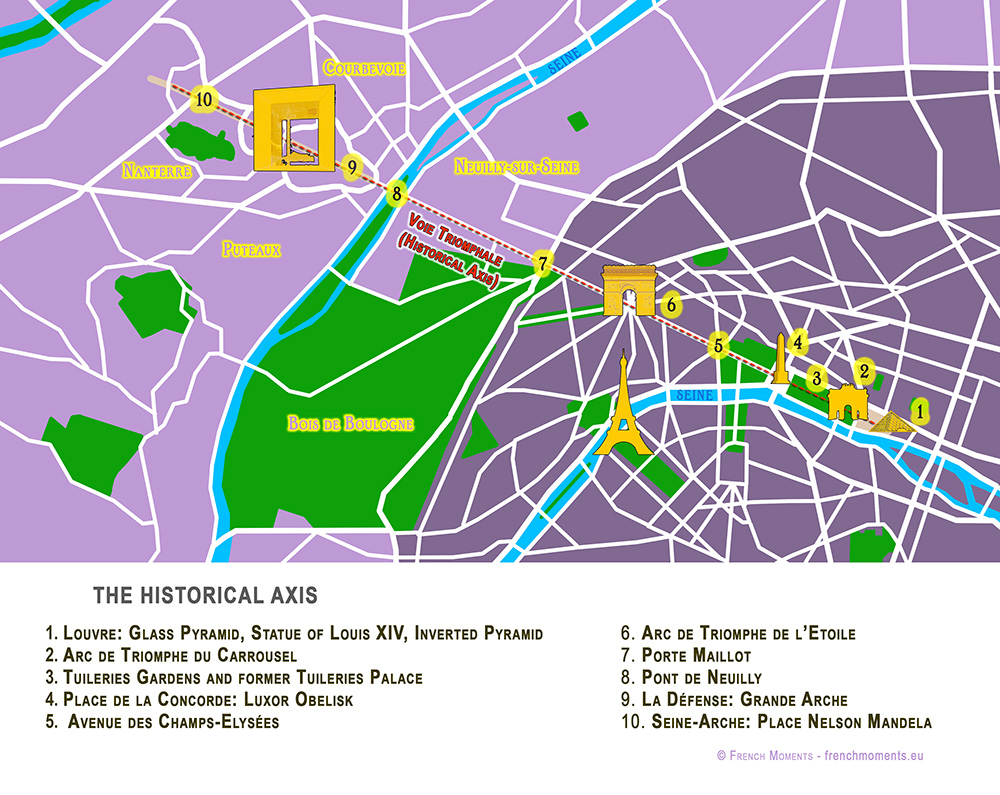
The Historical Axis runs through some of Paris’ most celebrated monuments and squares:
Let’s move along the Historical Axis of Paris, from East to West, starting from the Louvre.
The Palace of the Louvre
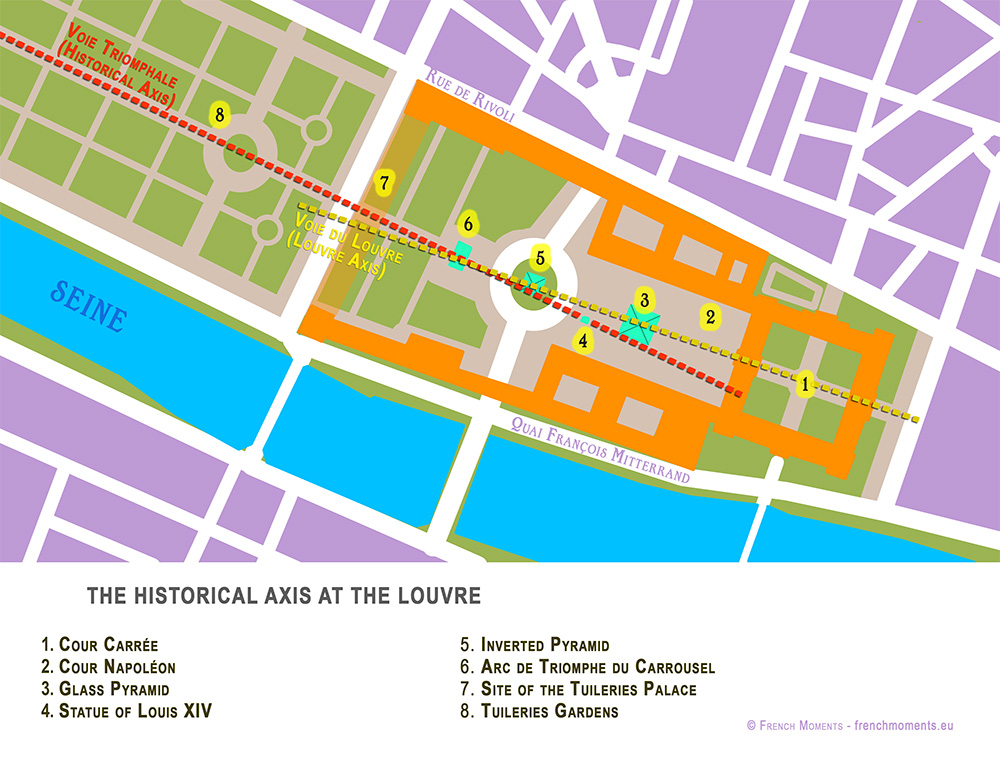
Today the great perspective starts at the Louvre, immediately beyond the Church of St Germain l’Auxerrois.
The crab-shaped Palace was the main residence of the kings of France until 1682, when Louis XIV, the ‘Sun King’, moved his court to Versailles. It currently houses one of the world’s most wonderful museums in a complex that is known as the “Grand Louvre”.
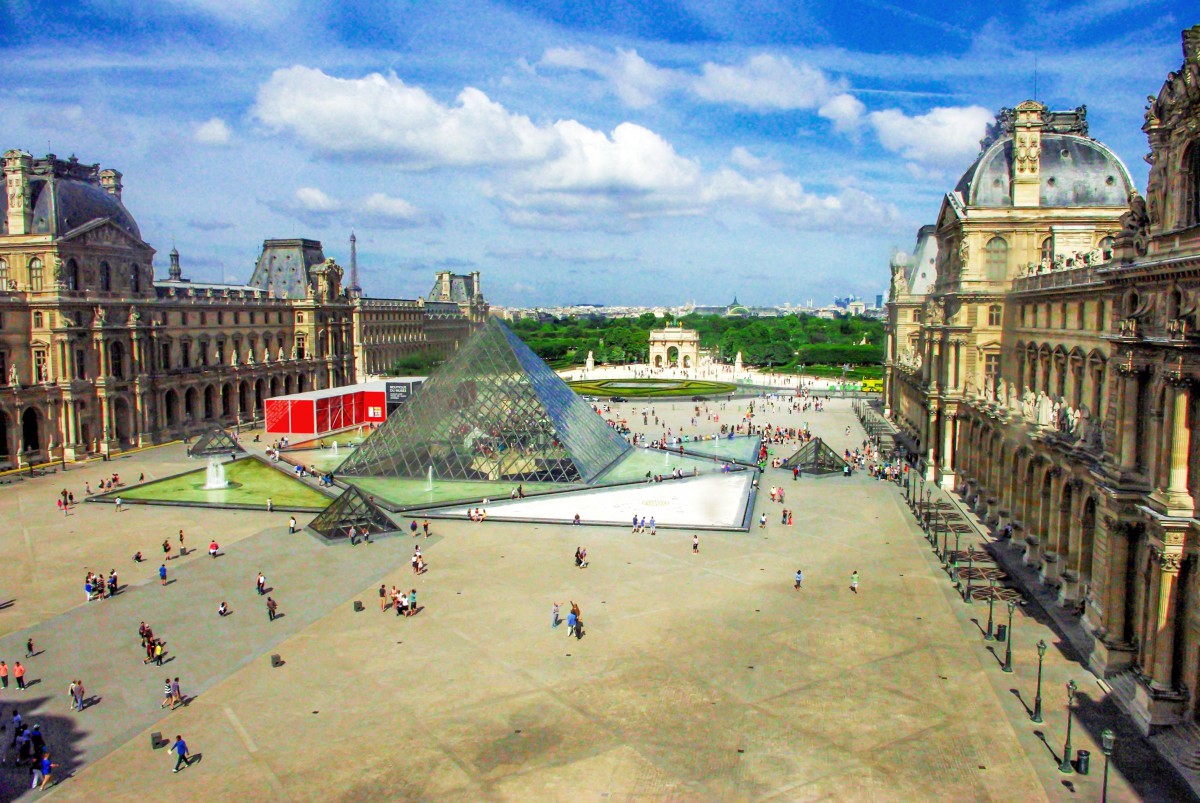 The Louvre today © French Moments The Louvre today © French Moments
The controversial glass pyramid of the Louvre
President François Mitterrand left his mark with his pharaonic project of “Le Grand Louvre”. He wished to complete it for the bicentennial celebration of the French Revolution in 1989. The titanic project comprised of major renovation works and the construction of a new landmark along the Historical Axis: the celebrated (and controversial) Glass Pyramid.
But if you look closer, you’ll notice that the glass pyramid is not aligned with the other monuments on the Historical Axis.
That’s why something had to be added in this vast courtyard of the Louvre…
https://frenchmoments.eu/historical-axis-of-paris-la-voie-triomphale/ |
|
|
|
|
Start-up of 22nd Run at the Relativistic Heavy Ion Collider (RHIC)
Physicists will try out innovative accelerator techniques and deliver high-energy polarized protons for explorations of protons' inner structure using new detector components at STAR
December 13, 2021
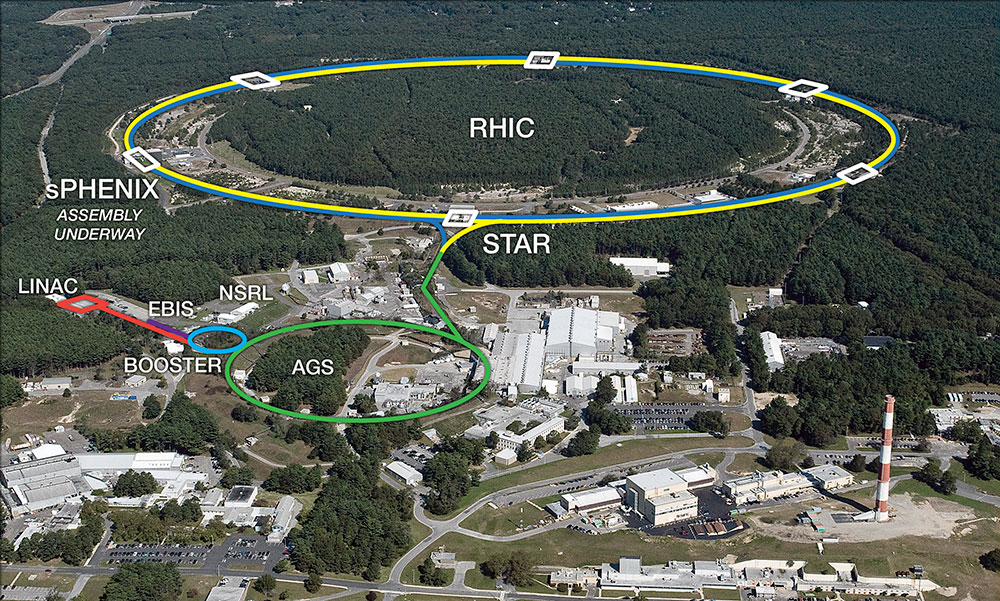 enlarge enlarge
Run 22 at the Relativistic Heavy Ion Collider (RHIC) will feature collisions of polarized protons, new data collected by upgraded components of the STAR detector, and tests of innovative accelerator techniques.
UPTON, NY—Particle smashups have begun for Run 22 at the Relativistic Heavy Ion Collider (RHIC). RHIC, a 2.4-mile-circumference particle collider at the U.S. Department of Energy’s Brookhaven National Laboratory, operates as a DOE Office of Science user facility, serving up data from particle collisions to nuclear physicists all around the world. On the menu this run: collisions between beams of polarized protons interspersed with tests of innovative accelerator techniques. During the run, RHIC’s recently upgraded STAR detector will track particles emerging from collisions at a wider range of angles than ever before.
The new data will add to earlier RHIC datasets exploring the fundamental building blocks of visible matter. In addition, the physics findings, accelerator tests, and detector technologies will play important roles in the Electron-Ion Collider (EIC)—DOE’s next planned nuclear physics facility, which will reuse key components of RHIC.
Discovering the universal properties of protons and how they emerge from the interactions of quarks and gluons, the building blocks within protons, is a central goal of both facilities. RHIC’s proton-proton collisions could reveal unprecedented details and a preview of how certain characteristics depend on the dynamic motions of the quarks and gluons.
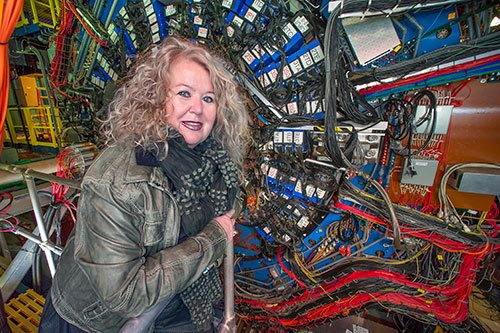 enlarge enlarge
Brookhaven Lab physicist Elke Aschenauer, who led the STAR upgrade project, notes how the new detector components will enable measurements at RHIC that advance our understanding of nucleon structure and help to lay the foundations for future measurements at the Electron-Ion Collider.
“Our goal this run is basically doing EIC physics with proton-proton collisions,” said Brookhaven Lab physicist Elke-Caroline Aschenauer, a member of the STAR collaboration who is also involved in planning the experiments and scientific program at the EIC. “It’s important to do both [measurements at RHIC and the EIC] because you have to verify that what you measure in electron-proton collisions at the EIC and in proton-proton events at RHIC is universal—meaning it doesn’t depend on which probe you use to measure it,” she explained.
The measurements rely on RHIC’s ability to align the “spins” of protons in an upward pointing direction. This alignment, or polarization—a capability unique among colliders like RHIC—gives scientists a directional frame of reference for tracking how particles generated in the collisions move.
“We are using polarization as a vehicle to study proton structure, and particularly the 3D structure, including how the internal particles (quarks and gluons) are moving inside the proton,” Aschenauer said.
Delivering proton beams
The physicists in Brookhaven Lab’s Collider-Accelerator Department (C-AD), who steer the beams around RHIC, are determined to give STAR what it needs.
“For Run 22 we are going to focus on being as efficient as possible and racking up the collisions at the highest possible polarization,” said C-AD physicist Vincent Schoefer, this year’s run coordinator.
When we spoke with Schoefer, he was busy “waking up” equipment that hasn't been used since Run 17—the last time polarized protons were collided at RHIC. This equipment includes “helical dipole” magnets that help preserve the polarization of the protons as they make millions of turns around RHIC’s twin accelerator rings. This year’s run will take place at the highest collision energy: 500 billion electron volts (GeV) per colliding proton pair.
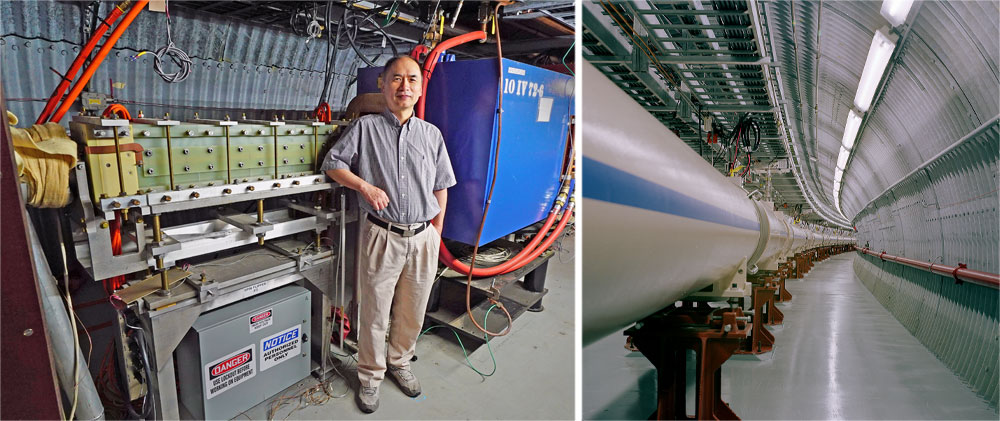 enlarge enlarge
C-AD physicist Haixin Huang with some of the accelerator components that keep RHIC's proton beams aligned as they make their way around the 2.4-mile-circumference tunnel (right).
The C-AD team was also preparing “polarimeters” to measure just how aligned those proton spins are.
“It doesn't matter how highly polarized your beam is if you can't measure that. So, the polarimetry is really crucial,” Schoefer said.
Accelerator physicists in C-AD and experimental physicists involved in making measurements that rely on polarized beams collaborated on the design of RHICs polarimeters.
“This work is an example of the type of collaboration between groups that has been going on since the start of RHIC,” said C-AD physicist Haixin Huang.
Pumping up polarization
Keeping proton beams tightly packed helps preserve polarization. It also maximizes the likelihood that you get collisions when the beams cross. But keeping protons close together is a challenge.
“They're all positively charged particles, so they want to repel one another,” Schoefer explained. “The more tightly you pack them, the more they resist that packing.”
The repulsion is particularly strong in the early stages of acceleration—before protons have been ramped up to full collision energy. So, this run, the C-AD team will try a technique that’s worked when RHIC accelerates larger particles but has never been used with protons before.
“We are going to split each proton bunch into two when they’re still at low energy in the Booster, and accelerate those as two separate bunches,” Schoefer said. “That splitting will alleviate some of the stress during low energy, and then we can merge the bunches back together to put very dense bunches into RHIC.”
This merging maneuver is challenging, Schoefer said, because it takes “a really long time—where a really long time is one second! For the protons, that’s 300,000 turns around the Alternating Gradient Synchrotron (AGS).” (The AGS is the link in the accelerator chain after the Booster that feeds particle beams into RHIC.) “During those 300,000 turns, we have to handle the protons very gently, so we don’t ruin the nice beams we have prepared.”
The CA-D team will also calculate very careful trajectories for the particles’ paths through the collider. This step should help counteract the tendency of the accelerator’s magnetic fields (which physicists use to steer and focus the beams) to rotate the spins of protons away from ideal alignment.
“We're going to try different trajectories and see if we can learn something about what is making this misalignment happen,” Schoefer said.
The combination of techniques is now delivering highly polarized proton beams to collide inside STAR.
STAR upgrades
When they analyze results from these collisions, STAR physicists will be looking for differences in the numbers of certain particles emerging to the left and right of the polarized protons’ upward pointing direction.
For example, they want to test whether there’s a repulsive interaction between particles with like “color” charges that’s opposite to the attractive interaction observed between unlike color-charged particles. (Color charge is the type of charge through which quarks interact.) The opposite force should produce the opposite directional preference for certain particle decay products.
STAR first saw hints of this effect in data collected in 2011, published in 2016. A preliminary analysis of additional data collected in Run 17 indicates a small effect but with large uncertainties. Run 22 will help STAR reduce those uncertainties with larger data sets.
In addition, the recently installed STAR upgrades will give physicists the ability to track particles at previously inaccessible angles toward the front and rear of the detector.
“This is the region where we expect the left-right directional preference to be larger,” Aschenauer said.
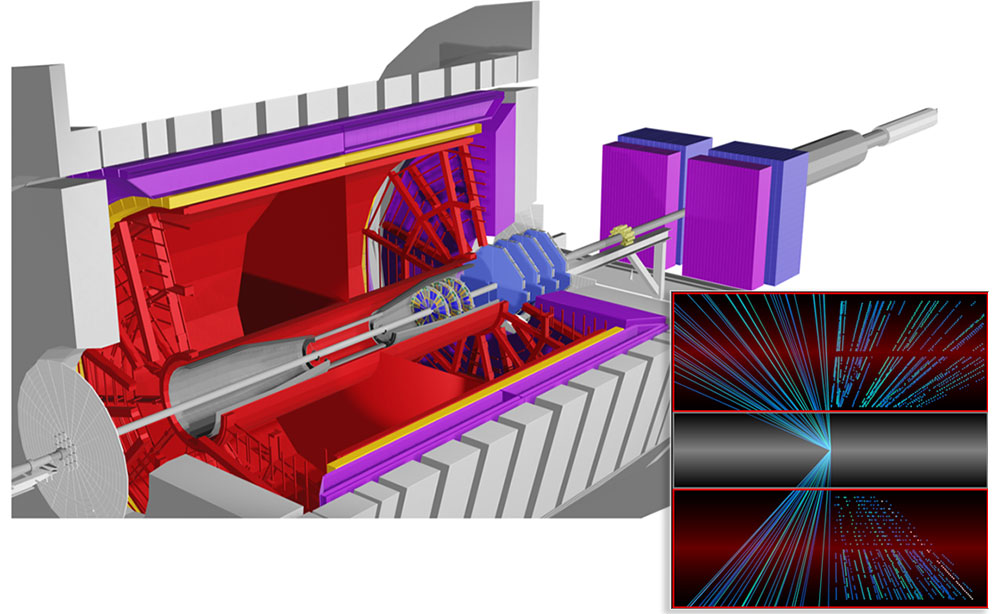 enlarge enlarge
A side view of the STAR detector with an inset showing particle tracks (left) and particle detector "hits" (right) from a collision. The top part of the inset shows the coverage with the new iTPC sectors compared to the old sectors (bottom). Notice how the new sectors record more hits per track, especially close to the beamline, as well as tracks at more forward and rearward angles (more to the left and right in the inset view).
The upgrades include an inner Time Projection Chamber (iTPC), installed in 2019, which placed many more sensors in the inner sectors of the cylindrical STAR detector, close to the colliding particles. Then, earlier this year, the STAR team installed “forward” particle-tracking components outside one end of the detector.
To picture how these upgrades increase STAR’s particle tracking range, think of STAR as a barrel lying on its side with colliding particles entering at each end. Ever since RHIC’s first collisions in 2000, STAR has tracked particles emerging perpendicular to the colliding particles’ path all around the barrel. The classic end-on views of STAR particle tracks showcase this 360-degree detection capability. But looking from the side, the original STAR detector could only track particles emerging at angles up to 45 degrees off vertical in either the forward or rearward direction.
The upgrades “open wider the cone where the particles can go and be detected,” said Zhenyu Ye, a STAR collaborator from the University of Illinois, Chicago. Ye led the design and construction of the new silicon-based particle-tracking components installed at the forward end of STAR, working with scientists from National Cheng Kung University in Tainan and Shandong University in Qingdao.
These components give scientists the ability to detect particles emerging almost in line with the colliding beams, including jets of particles that reveal information about the colliding quarks’ energy, direction, and spin.
“This information is essential for mapping the 3D arrangement of the proton’s inner building blocks,” said Chi Yang from Shandong University. Yang worked with colleagues from the University of Science and Technology of China and Brookhaven Lab to build additional subdetector systems for the forward tracking detector.
“These upgrades cover exactly the angles where jets would go in the EIC,” said Brookhaven Lab physicist Prashanth Shanmuganathan. So, in addition to increasing the data set for exploring the color charge interactions, “Run 22 will help us learn about the detector technology and the behavior of nucleon structure so we can apply that knowledge to the EIC.”
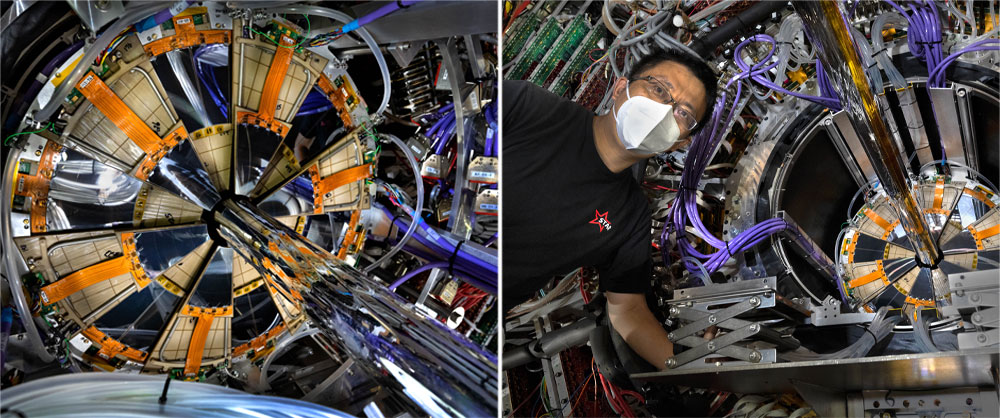 enlarge enlarge
Left: One plane of three silicon tracker detector modules installed around the beampipe at one end of the STAR detector. The shiny mirrorlike wedges, arrayed in alternating "inner" and "outer" positions, form a ring around the beampipe, with each sector connected to readout electronics. Right: Zhenyu Ye inspects the silicon tracker after insertion into the STAR Time Projection Chamber (TPC), where it will operate closer to the point where particles collide. Violet tubes encase signal readout cables while clear tubes carry a cooling fluid to the detector.
Cooling protons
Interspersed with delivering proton-proton collisions for STAR’s Run 22 measurements, the C-AD team will also spend the equivalent of two weeks’ time testing a technique for keeping high-energy protons tightly packed.
You’ll recall that keeping particles packed is important for maximizing collision rates and maintaining polarization. But particle spreading, or heating up, is a problem for all accelerated ion beams—from protons to uranium nuclei (the heaviest ions that have been collided at RHIC).
“There’s no natural shrinking of these ion beams; they never get denser by accident,” Schoefer said.
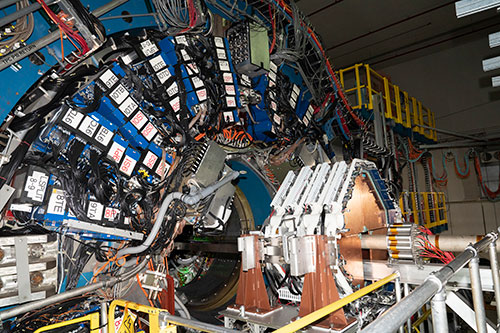 enlarge enlarge
This view of STAR shows the endcap calorimeter electronics (blue with black cables) and four new planes of small-strip Thin Gap Chambers (copper colored with white at edges).
So RHIC accelerator physicists have developed a variety of successful techniques to keep ion beams “cool.” Some of these cooling methods involve delivering “kicks” to push particles closer together, while others literally use cool beams of other particles (electrons) to extract heat from circulating ions.
Realizing that different cooling techniques work best for different types of particles at different energies, physicists are exploring several strategies for possible use at the EIC. In Run 22 they’ll test something called “coherent electron cooling” (CeC) on high energy polarized protons.
Instead of just being cool in temperature, as described above, the negatively charged electrons in CeC play a more active role: They clump around each positively charged proton to create a “mold” of the proton beam.
“It's a little bit like getting braces when the orthodontist takes a mold of your teeth,” Schoefer said. “We take a mold of the proton beam and then we adjust the electron beam slightly to attract the protons closer to a central position. As the electrons move, their electrical attraction drags the protons with them.”
In 36-hour stints, the C-AD physicists will test and try to fine-tune the technique.
Measuring ion polarization
In addition, every two weeks during Run 22, the C-AD team will stop proton acceleration for 12- to 16-hour stretches of accelerator R&D experiments. For one of these projects, they’ll ramp up beams of Helium-3 ions to work on methods for measuring the polarization of particles other than protons.
“In RHIC, the only polarized species we’ve ever had is polarized protons. But EIC will do experiments with polarized ions such as Helium-3. That’s an entirely different beast,” Schoefer said.
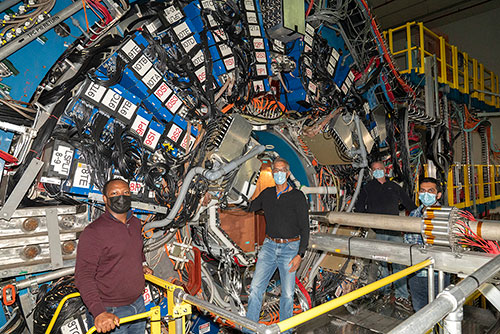 enlarge enlarge
Felix Archampong, Robert Soja, William Struble, and Rahul Sharma of the STAR technical support group completed the mechanical design, construction, and installation of the small-strip Thin Gap Chambers—shown here in position for collecting data—with support from the STAR electronic support group.
The C-AD team worked in collaboration with members of the “Cold-QCD” group in the Physics Department to design ways to measure the polarization of these more complicated ions.
To measure polarization, physicists spray a gas through the beam to act as a target, and measure how the particles in the beam scatter.
“For a proton, that’s already a challenge, but at least the proton stays a proton. When Helium-3 scatters off a target, it may break up into two protons and a neutron, or a proton and a deuteron. To accurately measure the polarization, we have to identify when breakup occurs,” said William Schmidke, a scientist in the physics department who’s been developing polarimetry detectors to make the measurements.
During Run 22, physicists will test the components’ ability to accurately characterize scattering products using unpolarized beams of Helium-3.
“We can do these tests, without measuring polarization, to develop the methods so we’ll be able to measure polarization when we eventually have polarized beams at the EIC,” said Brookhaven physicist Oleg Eyser, another member of the Cold-QCD team.
“Many people made important contributions to the detector and accelerator components needed for Run 22 at RHIC. We are looking forward to the exciting opportunities for physics discoveries and for advancing the technologies and physics analysis methods we will need for the EIC,” said Haiyan Gao, Brookhaven’s Associate Laboratory Director for Nuclear and Particle Physics.
Brookhaven National Laboratory is supported by the Office of Science of the U.S. Department of Energy. The Office of Science is the single largest supporter of basic research in the physical sciences in the United States and is working to address some of the most pressing challenges of our time. For more information, visit science.energy.gov.
https://www.bnl.gov/newsroom/news.php?a=119262 |
|
|
 Primer Primer
 Anterior
238 a 252 de 252
Següent Anterior
238 a 252 de 252
Següent
 Darrer
Darrer

|
|
| |
|
|
©2025 - Gabitos - Tots els drets reservats | |
|
|

